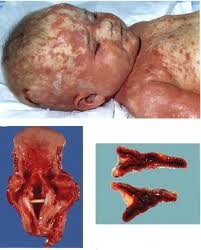Waterhouse-Friderichsen Syndrome Definition
Page Contents
- 1 Waterhouse-Friderichsen Syndrome Definition
- 2 Waterhouse-Friderichsen Syndrome Causes
- 3 Waterhouse-Friderichsen Syndrome Symptoms
- 4 Waterhouse-Friderichsen Syndrome Diagnosis
- 5 Waterhouse-Friderichsen Syndrome Treatment
- 6 Waterhouse-Friderichsen Syndrome Complications
- 7 Waterhouse-Friderichsen Syndrome Prognosis
- 8 Waterhouse-Friderichsen Syndrome Prevention
Waterhouse-Friderichsen Syndrome (WFS) is a condition characterized by adrenal gland failure caused by bleeding into adrenal glands as a result of severe bacterial infection, the most common of which is the meningococcus Neisseria meningitidis.
The condition is named after an English physician named Rupert Waterhouse and Danish pediatrician Carl Friderichsen who wrote several papers describing this condition. The syndrome is also referred to as Fulminant meningococcemia or hemorrhagic adrenalitis.
Waterhouse-Friderichsen Syndrome Causes
Waterhouse-Friderichsen syndrome can be caused by infections from various species of bacteria. Neisseria meningitides, also known as Meningococcus is known to cause blood infections that generally underlie WFS. Although there are many infectious agents that can affect the adrenal glands, an acute, definitive infection is generally caused by Meningococcus.
Pseudomonas aeruginosa is another bacterium that causes WFS.
The syndrome can also result from Streptococcus pneumoniae infections. This common bacterial pathogen is typically associated with occurrence of meningitis in adult and elderly populations.
WFS is also caused by mycobacterium tuberculosis. Tubercular invasion of adrenal glands could lead to hemorrhagic destruction of these glands and ultimately result in mineralocorticoid deficiency.
Staphylococcus aureus is known to cause pediatric WFS.
Adrenal insufficiency can be caused by Cytomegalovirus in immunocompromised patients.
The condition can also be linked with Gram negative organisms such as pasturella, klebsiella, Escherichia coli and Haemophilus influenzae.
In some rare cases, WFS can occur as a result of taking medications that promote clotting of blood. Other factors might include:
- Steroid usage
- Low platelet counts
- Renal vein thrombosis
- Primary antiphospholipid syndrome
The condition is highly contagious, although it requires a fairly close contact between an affected and a non-affected individual for the infection to spread. A healthy person might get ill by kissing an affected individual or through exchange of larger respiratory droplets.
Waterhouse-Friderichsen Syndrome Symptoms
This type of bacterial infection causes massive hemorrhage into one or generally both of the adrenal glands. This is characterized by severe bacterial infection meningococcemia that leads to:
- Massive organ failure
- Blood invasion
- Low blood pressure
- Shock
- Coma
- Disseminated intravascular coagulation (DIC) accompanied by widespread purpura, rapidly progressing adrenocortical insufficiency and even death.
WFS can be said to be a worse type of meningococcal septicemia. Onset of the disorder is nonspecific and shows signs such as:
- Rigors
- Fever
- Headache
- Perspiration
- Diarrhea
- Vomiting
- Malaise
- Chilly sensations
- Abdominal pain
- Muscular pains
The pulse rate is accelerated throughout the condition. A rash appears soon which is initially macular, and not having much difference from the type of spots seen in typhoid. The spots soon become petechial and purpuric, developing a dusky gray tone. Low blood pressure or hypotension occurs as a rule that rapidly progresses to septic shock. Cyanosis of extremities is often impressive and the infected individual is quite prostrated or comatose. Meningitis normally does not occur in this type of meningococcal disease. There is hypoglycemia along with hyperkalemia and hyponatremia, and ACTH stimulation test shows acute adrenal failure. It is not required for leukocytosis to be extreme. Signs of leukopenia might be seen, which is considered to be a very poor sign of prognosis. C-reactive protein levels remain almost normal or can be elevated.
In some occasions, Thrombocytopenia is extreme with alterations in PT or prothrombin time and partial thromboplastin time or PTT that suggests diffuse intravascular coagulation or DIC. Acute renal failure and acidosis can be found along with severe sepsis. It is possible to culture Meningococci from CSF or blood, and is sometimes visible in cutaneous lesion smears. Atrophication of the tongue, dysphagia, as well as visibility of cracks around the corners of a patient’s mouth is also among the characteristic features of this disorder.
Waterhouse-Friderichsen Syndrome Diagnosis
WFS patients require a uniform criterion for proper diagnosis as the incidence of this condition is on the rise. Based on data gathered from clinics and laboratories, the following signs have been decided to be diagnostically significant:
- Albuminuria
- Facial edema
- Severe shock
- Marked oliguria
- Marked leukocytosis
- Hematuria or cylindruria
- Elevation of blood sodium
- Diminution of blood potassium
- Anuria of 24 to 36 hours’ duration
- Petechial eruptions rapidly turning purpuric
- Urinalysis demonstrating fixation of specific gravity
- Renal failure, as proven by the elevation of blood nonprotein creatinin and nitrogen
- Isolation of meningococcus by blood culture and occasionally by peripheral blood smears
Diagnosis of the condition cannot be solely based on any single factor mentioned above. Studies infer that the clinical signs are enough to determine the diagnosis in all acute, fulminating cases. When more prolonged courses are considered additional factors, that involve changes in the blood chemistry and isolation of meningococcus, should also be consistently present in order to conclusively confirm the diagnosis.
Waterhouse-Friderichsen Syndrome Treatment
This disorder is considered to be a medical emergency that needs to be treated immediately using adequate antibiotics as soon as possible. The drug Benzylpenicillin was once thought to be ideal along with chloramphenicol in allergic patients. The antibiotic Ceftriaxone is commonly in use today. Hypoadrenal shock can sometimes be reversed by the use of hydrocortisone. Grafting and plastic surgery is sometimes done to treat tissue necrosis.
Management of this syndrome also involves like treatment of toxemia, shock, bacteremia as well as administration of therapy conducted by adrenocortical hormone substitution. Heat and stimulants are used to treat shock and the antishock position is recommended. Parenteral fluids should be administered cautiously over 24 hours in measurements of 3000-4000cc. Around 500cc of intravenous plasma should be repeatedly given after 12 hours which will create an osmotic effect and noticeably increase the blood pressure.
Toxemia produced by this condition is directly responsible for the pathologic changes that can be seen in WFS. Although physicians are not sure at present as to how serotherapy can help in meningococcal infections, administering intravenous antimeningococcus serum in sufficient amounts (60000 to 120000 units) within first 24 hours seems to be advisable.
Chemotherapy has made it possible to have control over meningococcemia. The condition is often treated with sulfadiazine which is administered in large doses either parenterally or orally. Therapy with adrenocortical hormone substitution has been used to combat adrenal dysfunction in Waterhouse-Friderichsen syndrome that results from extensive necrosis and hemorrhages. However, the effectiveness of this form of therapeutic measure is in question and although not much clinical improvement could be detected in cases where it was used, the method was known to prolong the duration of the overall clinical course.
Waterhouse-Friderichsen Syndrome Complications
WFS might lead to the following complications:
- Shock
- Acute adrenal gland insufficiency
Waterhouse-Friderichsen Syndrome Prognosis
Early diagnosis and immediate treatment is necessary for ensuring the survival of a WFS patient. The syndrome can affect both children and adults alike. If the complications associated with the syndrome, such as massive organ failure or adrenocortical insufficiency progresses to an advanced stage, it might even lead to death.
Waterhouse-Friderichsen Syndrome Prevention
The Center for Disease Control recommends routine vaccinations against meningococcus for all individuals between 11 and 18 years as well as for people having poor splenic function or certain immune disorders like complement deficiency.
Waterhouse-Friderichsen Syndrome is an abnormal condition of the adrenal glands that occur due to bacterial infection. Considered as a medical emergency, it requires immediate medical attention as progression of the disorder might lead to the onset of severe complications or even death.


